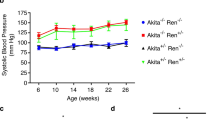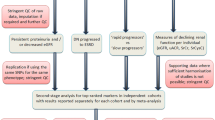Abstract
Although diabetic nephropathy occurs in only a minority of patients with diabetes, it is the major cause of end-stage renal disease in the United States. Hyperglycemia and hypertension are important factors predisposing patients to diabetic nephropathy, but accumulating evidence points to critical genetic factors predisposing only a subset of patients with diabetes to nephropathy. It has been challenging to define the genes conferring risk for nephropathy in human populations. Comparative genomics using the robust genetic reagents available in laboratory mice should provide a complementary approach to defining genes that may predispose to diabetic nephropathy in mice and humans. This article reviews new studies to identify genetic risk factors for diabetic nephropathy and the unique approaches that may be used to elucidate the genetic pathogenesis of this disorder in mice.
Similar content being viewed by others
References and Recommended Reading
Parving HH: Initiation and progression of diabetic nephropathy. N Engl J Med 1996, 335:1682–1683.
US Renal Data System: Excerpts from the USRDS 2005 annual data report. Am J Kidney Dis 2005, 47:S1–S286.
Retinopathy and nephropathy in patients with type 1 diabetes four years after a trial of intensive therapy. The Diabetes Control and Complications Trial/Epidemiology of Diabetes Interventions and Complications Research Group [no authors listed]. N Engl J Med 2000, 342:381–389.
Krolewski M, Eggers PW, Warram JH: Magnitude of end-stage renal disease in IDDM: a 35 year follow-up study. Kidney Int 1996, 50:2041–2046.
Knowler WC, Coresh J, Elston RC, et al.: The Family Investigation of Nephropathy and Diabetes (FIND): design and methods. J Diabetes Complications 2005, 19:1–9.
Seaquist ER, Goetz FC, Rich S, Barbosa J: Familial clustering of diabetic kidney disease. Evidence for genetic susceptibility to diabetic nephropathy. N Engl J Med 1989, 320:1161–1165.
Iyengar SK, Abboud HE, Goddard KAB, et al.: Genome-wide scans for diabetic nephropathy and albuminuria in multiethnic populations: the Family Investigation of Nephropathy and Diabetes. Diabetes 2007, 56:1577–1585.
Chavers BM, Bilous RW, Ellis EN, et al.: Glomerular lesions and urinary albumin excretion in type I diabetes without overt proteinuria. N Engl J Med 1989, 320:966–970.
Breyer MD, Bottinger E, Brosius FC 3rd, et al.: Mouse models of diabetic nephropathy. J Am Soc Nephrol 2005, 16:27–45.
Beck JA, Lloyd S, Hafezparast M, et al.: Genealogies of mouse inbred strains. Nat Genet 2000, 24:23–25.
Wade CM, Daly MJ: Genetic variation in laboratory mice. Nat Genet 2005, 37:1175–1180.
Yang H, Bell TA, Churchill GA, Pardo-Manuel de Villena F: On the subspecific origin of the laboratory mouse. Nat Genet 2007, 39:1100–1107.
Gurley SB, Clare SE, Snow KP, et al.: Impact of genetic background on nephropathy in diabetic mice. Am J Physiol Renal Physiol 2006, 290:214–222.
Qi Z, Fujita H, Jin J, et al.: Characterization of susceptibility of inbred mouse strains to diabetic nephropathy. Diabetes 2005, 54:2628–2637.
Ma LJ, Fogo AB: Model of robust induction of glomerulosclerosis in mice: importance of genetic background. Kidney Int 2003, 64:350–355.
Qi Z, Whitt I, Mehta A, et al.: Serial determination of glomerular filtration rate in conscious mice using FITC-insulin clearance. Am J Physiol Renal Physiol 2004, 286:F590–F596.
Mathews CE, Langley SH, Leiter EH: New mouse model to study islet transplantation in insulin-dependent diabetes mellitus. Transplantation 2002, 73:1333–1336.
Festing MF, Simpson EM, Davisson MT, Mobraaten LE: Revised nomenclature for strain 129 mice. Mamm Genome 1999, 10:836.
Hartner A, Cordasic N, Klanke B, et al.: Strain differences in the development of hypertension and glomerular lesions induced by deoxycorticosterone acetate salt in mice. Nephrol Dial Transplant 2003, 18:1999–2004.
Susztak K, Bottinger E, Novetsky A, et al.: Molecular profiling of diabetic mouse kidney reveals novel genes linked to glomerular disease. Diabetes 2004, 53:784–794.
Park CW, Kim HW, Ko SH, et al.: Accelerated diabetic nephropathy in mice lacking the peroxisome proliferator-activated receptor {alpha}. Diabetes 2006, 55:885–893.
Sharma K, McCue P, Dunn SR: Diabetic kidney disease in the db/db mouse. Am J Physiol Renal Physiol 2003, 284:1138–1144.
Naggert JK, Mu JL, Frankel W, et al.: Genomic analysis of the C57BL/Ks mouse strain. Mamm Genome 1995, 6:131–133.
Pillebout E, Burtin M, Yuan HT, et al.: Proliferation and remodeling of the peritubular microcirculation after nephron reduction: association with the progression of renal lesions. Am J Pathol 2001, 159:547–560.
Zheng S, Noonan WT, Metreveli NS, et al.: Development of late-stage diabetic nephropathy in OVE26 diabetic mice. Diabetes 2004, 53:3248–3257.
Zheng Z, Schmidt-Ott KM, Chua S, et al.: A Mendelian locus on chromosome 16 determines susceptibility to doxorubicin nephropathy in the mouse. Proc Natl Acad Sci U S A 2005, 102:2502–2507.
Kimura M, Takahasi H, Ohtake T, et al.: Interstrain differences in murine daunomycin-induced nephrosis. Nephron 1993, 63:193–198.
Tay YC, Wang Y, Kairaitis L, et al.: Can murine diabetic nephropathy be separated from superimposed acute renal failure? Kidney Int 2005, 68:391–398.
Ikeda H: KK mouse. Diabetes Res Clin Pract 1994, 24:S313–S316.
Shike T, Gohda T, Tanimoto M, et al.: Chromosomal mapping of a quantitative trait locus for the development of albuminuria in diabetic KK/Ta mice. Nephrol Dial Transplant 2005, 20:879–885.
Zanchi A, Moczulski DK, Hanna LS, et al.: Risk of advanced diabetic nephropathy in type 1 diabetes is associated with endothelial nitric oxide synthase gene polymorphism. Kidney Int 2000, 57:405–413.
Shin Shin Y, Baek SH, Chang KY, et al.: Relations between eNOS Glu298Asp polymorphism and progression of diabetic nephropathy. Diabetes Res Clin Pract 2004, 65:257–265.
Zhao HJ, Wang S, Cheng H, et al.: Endothelial nitric oxide synthase deficiency produces accelerated nephropathy in diabetic mice. J Am Soc Nephrol 2006, 17:2664–2669.
Kanetsuna Y, Takahashi K, Nagata M, et al.: Deficiency of endothelial nitric-oxide synthase confers susceptibility to diabetic nephropathy in nephropathy-resistant inbred mice. Am J Pathol 2007, 170:1473–1484.
Nakagawa T, Sato W, Glushakova O, et al.: Diabetic endothelial nitric oxide synthase knockout mice develop advanced diabetic nephropathy. J Am Soc Nephrol 2007, 18:539–550.
Frye EB, Degenhardt TP, Thorpe SR, Baynes JW: Role of the Maillard reaction in aging of tissue proteins. Advanced glycation end product-dependent increase in imidazolium cross-links in human lens proteins. J Biol Chem 1998, 273:18714–18719.
Cohen MP: Intervention strategies to prevent pathogenetic effects of glycated albumin. Arch Biochem Biophys 2003, 419:25–30.
Vlassara H, Brownlee M, Cerami A: Nonenzymatic glycosylation of peripheral nerve protein in diabetes mellitus. Proc Nat Acad Sci U S A 1981, 78:5190–5192.
Wendt T, Tanji N, Guo J, et al.: Glucose, glycation, and RAGE: implications for amplification of cellular dysfunction in diabetic nephropathy. J Am Soc Nephrol 2003, 14:1383–1395.
Hofmann MA, Drury S, Fu C, et al.: RAGE mediates a novel proinflammatory axis: a central cell surface receptor for S100/calgranulin polypeptides. Cell 1999, 97:889–901.
Lander HM, Tauras JM, Ogiste JS, et al.: Activation of the receptor for advanced glycation end products triggers a p21(ras)-dependent mitogen-activated protein kinase pathway regulated by oxidant stress. J Biol Chem 1997, 272:17810–17814.
Wendt TM, Tanji N, Guo J, et al.: RAGE drives the development of glomerulosclerosis and implicates podocyte activation in the pathogenesis of diabetic nephropathy. Am J Pathol 2003, 162:1123–1137.
Inagi R, Yamamoto Y, Nangaku M, et al.: A severe diabetic nephropathy model with early development of nodule-like lesions induced by megsin overexpression in RAGE/iNOS transgenic mice. Diabetes 2006, 55:356–366.
Yamamoto Y, Kato I, Doi T, et al.: Development and prevention of advanced diabetic nephropathy in RAGE-overexpressing mice. J Clin Invest 2001, 108:261–268.
Dunn SR, Qi Z, Bottinger EP, et al.: Utility of endogenous creatinine clearance as a measure of renal function in mice. Kidney Int 2004, 65:1959–1967.
Yuen PS, Dunn SR, Miyaji T, et al.: A simplified method for HPLC determination of creatinine in mouse serum. Am J Physiol Renal Physiol 2004, 286:1116–1119.
Kakoki M, Takahashi N, Jennette JC, Smithies O: Diabetic nephropathy is markedly enhanced in mice lacking the bradykinin B2 receptor. Proc Nat Acad Sci USA 2004, 101:13302–13305.
Tan Y, Keum JS, Wang B, et al.: Targeted deletion of B2-kinin receptors protects against the development of diabetic nephropathy. Am J Physiol Renal Physiol 2007, Jun 27; [Epub ahead of print].
Hrabe de Angelis MH, Flaswinkel H, et al.: Genome-wide, large-scale production of mutant mice by ENU mutagenesis. Nat Genet 2000, 25:444–447.
Favor J: Mechanisms of mutation induction in germ cells of the mouse as assessed by the specific locus test. Mutat Res 1999, 428:227–236.
Beier DR: Sequence-based analysis of mutagenized mice. Mamm Genome 2000, 11:594–597.
Cordes SP: N-ethyl-N-nitrosourea mutagenesis: boarding the mouse mutant express. Microbiol Mol Biol Rev 2005, 69:426–439.
Nolan PM, Hugill A, Cox RD: ENU mutagenesis in the mouse: Application to human genetic disease. Brief Funct Genomic Proteomic 2002, 1:278–289.
Nadeau JH, Frankel WN: The roads from phenotypic variation to gene discovery: mutagenesis versus QTLs. Nat Genet 2000, 25:381–384.
Su LK, Kinzler KW, Vogelstein B, et al.: Multiple intestinal neoplasia caused by a mutation in the murine homolog of the APC gene. Science 1992, 256:668–670.
Vitaterna MH, King DP, Chang AM, et al.: Mutagenesis and mapping of a mouse gene, Clock, essential for circadian behavior. Science 1994, 264:719–725.
Imperatore G, Knowler WC, Pettitt DJ, et al.: Segregation analysis of diabetic nephropathy in Pima Indians. Diabetes 2000, 49:1049–1056.
Vardarli I, Baier LJ, Hanson RL, et al.: Gene for susceptibility to diabetic nephropathy in type 2 diabetes maps to 18q22.3–23. Kidney Int 2002, 62:2176–2183.
Tchekvena EE, Rinchik EM, Polosukhina D, et al.: A sensitized screen of ENU mutagenized mice identifies dominant mutants predisposed to diabetic nephropathy. J Am Soc Nephrol 2007, 18:103–112.
Flint J, Valdar W, Shifman S, Mott R: Strategies for mapping and cloning quantitative trait genes in rodents. Nat Rev Genet 2005, 6:271–286.
Stoll M, Kwitek-Black AE, Cowley AW Jr, et al.: New target regions for human hypertension via comparative genomics. Genome Res 2000, 10:473–482.
Sugiyama F, Churchill GA, Higgins DC, et al.: Concordance of murine quantitative trait loci for salt-induced hypertension with rat and human loci. Genomics 2001, 71:70–77.
Korstanje R, DiPetrillo K: Unraveling the genetics of chronic kidney disease using animal models. Am J Physiol Renal Physiol 2004, 287:347–352.
Vitt U, Gietzen D, Stevens K, et al.: Identification of candidate disease genes by EST alignments, synteny, and expression and verification of Ensembl genes on rat chromosome 1q43-54. Genome Res 2004, 14:640–650.
Clee SM, Yandell BS, Schueler KM, et al.: Positional cloning of Sorcs1, a type 2 diabetes quantitative trait locus. Nat Genet 2006, 38:688–693.
Klein RF, Allard J, Avnur Z, et al.: Regulation of bone mass in mice by the lipoxygenase gene Alox15. Science 2004, 303:229–232.
Wang X, Ria M, Kelmenson PM, et al.: Positional identification of TNFSF4, encoding OX40 ligand, as a gene that influences atherosclerosis susceptibility. Nat Genet 2005, 37:365–372.
Peirce JL, Lu L, Gu J, et al.: A new set of BXD recombinant inbred lines from advanced intercross populations in mice. BMC Genet 2004, 5:7.
Author information
Authors and Affiliations
Corresponding author
Rights and permissions
About this article
Cite this article
Breyer, M.D., Tchekneva, E., Qi, Z. et al. Examining diabetic nephropathy through the lens of mouse genetics. Curr Diab Rep 7, 459–466 (2007). https://doi.org/10.1007/s11892-007-0078-3
Published:
Issue Date:
DOI: https://doi.org/10.1007/s11892-007-0078-3




